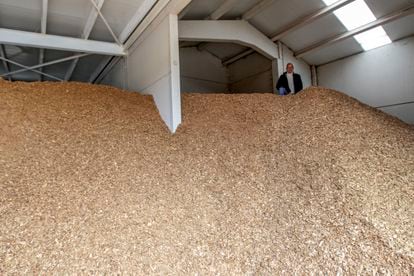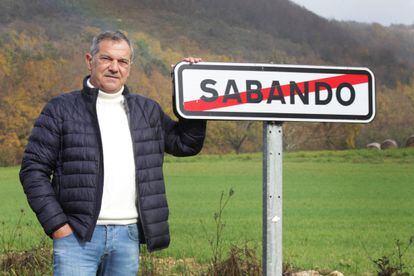A narrow, winding road winds between mountains painted with the colors of autumn—light greens, dark greens, and an infinite range of browns—in the Alavesa Mountainnext to Izki natural park. After nine kilometers of curves, Sabando appears, a Basque town of barely 50 inhabitants that hides a surprise: one of the first community heat networks in Spain. When it was launched a decade ago, the neighbors did not trust it and many also kept their individual heaters “just in case.” Ten years later, the collective system has proven to be efficient, cheap and consume 30% less firewood, in addition to becoming an example for other municipalities.
Shared heating systems with biomass are still an exception in Spain: there are less than a hundred networks in homes and apartment blocks, according to the report Biomass Heat Networks of the Spanish Biomass Association (Avebiom); However, experts point out that they can reach many more places and help in decarbonization, especially in rural areas with forests or agricultural remains, but also in certain urban areas.
biomass It is a renewable energy source that can come from materials of forest origin – for example, tree cuts in dense areas of the mountain that serve for efficient forest management – but also from agricultural, livestock, and even urban waste origin. “Trees fix CO₂ during their growth and when you burn them they emit it, then the balance is neutral. It is much worse to emit CO₂ from fossil fuels that has been fixed for centuries. In any case, it must be managed well to take advantage of existing resources and never carry out excessive felling,” explains Mario Rodríguez, from the environmental NGO Ecodeswho leads the Platform for the Decarbonization of Heating and Hot Water. “It is also important that the raw material is not more than 50 or 60 kilometers from the point where it is going to be burned,” he continues.
All of these characteristics are met in Sabando, a small town with only two streets, La Mayor and Mediodía – crossed by a stream -, marked by large stone houses, although there are also wood and concrete houses. On one side, the steep mountain of Aldaya, with its stone cliffs; to the other, the Abitigarra, both with leafy oak and beech forests. “In Álava and Navarra many mountains are communal, as is the case in Sabando. So neighbors have the right to get firewood. A guard from the county council tells us which trees we can cut to clear the forest in the thickest areas and avoid fires, and we use them for firewood,” explains Ángel Marcos Pérez de Arrilucea, mayor of the municipality, 57 years old. “Before each neighbor did it and now we do it together,” he adds.

Information is the first tool against climate change. Subscribe to it.
Subscribe
The town is constituted as an administrative board, a step below the town hall that gives autonomy to residents to decide on local matters. A decade ago, they took advantage of some sanitation works to install the biomass system. “At first there was quite a bit of suspicion. There are about 40 homes in the town and at first we added 16, but we left the installation ready for all of them. Now there are 24 of us,” says the councilor, who is also a farmer. It cost about 550,000 euros, most of which was paid for by both the Basque Government and the Álava Provincial Council; The neighbors had to take care of only 90,000 with a 10-year loan.
The Institute for Energy Diversification and Saving (IDAE) from the Ministry for the Ecological Transition also has aid: last July it financed 18 biomass projects with 31.7 million euros. The IDAE considers that “efficient heat and cold networks, with a high percentage of thermal energy generation through renewable energy or waste heat, are a fundamental tool to save energy by improving energy efficiency and increasing the share of renewables in the air conditioning of buildings, both effects contributing to the reduction of CO₂″ emissions.
How does it work in Sabando? The neighbors commission a company to cut down the trees for which they have permission and bring them to town. Then another company cuts them into chips. During two weeks of summer, they take the opportunity to spread them on the only sports court in the town to dry. “We all try to do it, both spreading it and then cleaning it. I also help with each neighbor's bills. It is something that we all have to take care of,” says Virginia Jalón, a 37-year-old neighbor. They use about 350 tons a year, and that's plenty. “If we had 40 individual heaters we would need more than 500 tons, around 30% more, this system is much more efficient,” explains Pérez de Arrilucea.

Later, they take the shavings to two large covered warehouses at the entrance to the town. There are so many that they don't fit inside and they accumulate outside. Enrique Elizondo, a 68-year-old retired farmer — “I was born here and I will die here” — climbs with agility up the mountain of chips — “we use beech wood, because it dries sooner” — that fills the first warehouse: “In this part that Attached to the wall are the two areas from which the boilers directly suck the wood. Normally we try to mix wood from inside and outside.” That, like everything—maintenance, cleaning—is taken care of by the neighbors, who also vote on all the decisions, so they function as an energy community, even though they are not legally constituted as such.
On the other side of that wall is the engine room, with two large boilers that use heat to heat a 5,000-liter tank. The water comes out at 80 degrees, runs through the entire town in two large pipes and returns, after a long journey, at 70 degrees. Afterwards, each house has an exchanger so that that heat – but not the water – is transferred to the water in each home, and thus have heating and hot water. “If community water reached each home, any breakdown in one house would affect the entire system,” says the councilor. In addition, each home has a 200-liter hot water tank, in case at any time they have to stop or clean the main system—as they do for two summer days.
A cheap system
The neighbors are aware of having a cutting-edge and comfortable system, which saves between 40% and 60% of the cost compared to gas heating. The average annual bill varies between 600 and 1,000 euros, when with gas – which is also a fossil fuel – it is around 2,500. The energy used by each neighbor is billed at 0.025 per kW, which pays for the costs of firewood, maintenance and electricity for the water pumps. “I have a large house, about 150 square meters, with high ceilings and stone walls, and I also have the heating on all day because I have two small children, and despite everything I pay less for heating than any small apartment in Victory. In other towns and cities they freak out when I tell them and they envy us,” explains Hibai Fernández de Jáuregui, a 34-year-old resident who works in a motorcycle workshop in a nearby town.
Joseba Grandes, 37, lives in another beautiful two-story stone house nearby and also has two small children: “The system works very well, you set the thermostat to the temperature you want and you forget about it. “It’s a good way to warm up the house.” Despite being such a small nucleus, in Sabando there are seven small children — all of them go to school or daycare in nearby Maeztu. “If you improve the living conditions with this type of system, you help establish the population, because there is a lot of comfort in large houses at a low price,” summarizes Rodríguez, from Ecodes. Carlos, a taxi driver in nearby San Vicente de Arana, confirms that in his town – which has twice the population of Sabando – no children have been born in a long time.

Mayor Pérez de Arrilucea considers that biomass has also “improved social relations in the town,” because now “we have more things we do in common.” Pilar Berreta, a 68-year-old retiree, confirms this on the porch of her stone house: “Cutting firewood for a family is a lot of work, but now we do it together and it is much easier. Besides, we get older and it is always better to have the help of others.”
Sabando is serving as an example for other municipalities: Pérez de Arrilucea has given talks in several Spanish towns explaining how they manage it. Furthermore, the Basque cooperative Goiener develops the European project BeCoop to promote the community use of biomass and they have also taken notice of them. “We did a study for the Aberasturi council, in Vitoria, where there are 60 homes, and we visited Sabando with them so they could get to know it. We have already done the project and now they are looking for financing,” says Pablo Castells, head of the BeCoop project in Goiener. “Many other towns could have similar networks to take advantage of the forests, which also generate local employment and establish population,” he continues.
Thousands of homes in Soria
They have also reached some cities. “In Spain there are 479 heat and cold networks with biomass, the vast majority serve municipalities that use them for public facilities, although there are also about 90 that serve homes and apartment blocks,” summarizes Juan José Ramos, technician of Avebiom. “Some have reached the cities: in Soria there are already thousands of homes hooked up to the municipality's heat network, which has become a private company and works with forest remains, and there are others in Móstoles and Aranda de Duero. Although it is not the same, in Barcelona there is a network with biomass and gas: the port regasification plant, instead of throwing the cold into the sea, offers it to homes, industries and hotels,” he adds.
Rodríguez, from Ecodes, points out that both the energy efficiency directive in buildings and the future co
-design regulation indicate that in 2030 we will have to begin to do without gas boilers: “In front of them we have three alternatives, heat pumps powered by renewable energy, concentrated solar energy to heat water and biomass boilers. The latter can also extend to municipalities with agricultural remains such as olive pits, almond shells, prunings, straw, cereals and even urban waste.” In his opinion, “it is a consolidated type of heating that works, but it is not widespread because not much is known yet.”
Back in Sabando, the fog turns into fine rain, which they call txirimi here, and the atmosphere cools down. Night is falling. “Every winter it usually snows and the town becomes beautiful,” says the mayor, while he shows on his cell phone how the white mantle makes this small enclave even more beautiful. “Before, older people used to go to the city to spend the winters, but now with biomass we all stay at home, warm,” he says, proudly.
You can follow CLIMATE AND ENVIRONMENT in Facebook and xor sign up here to receive our weekly newsletter
Subscribe to continue reading
Read without limits
_
#town #heats #waste #forest #community #heat #networks #Spain #works

